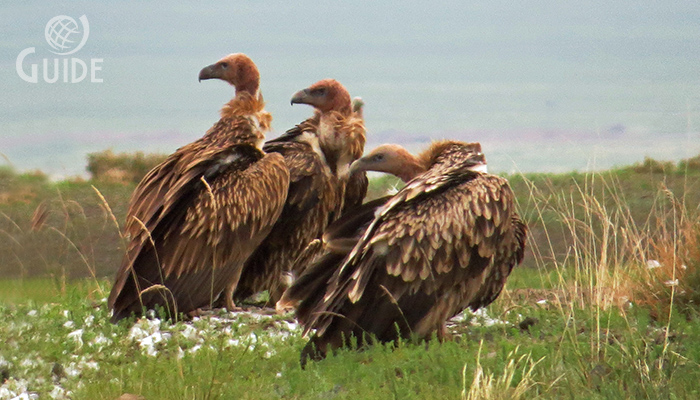
English: Griffon Vulture, Eurasian Griffon Vulture
Russian: Белоголовый сип
German: Gansegeier
French: Vautour
fauve
Mongolian: Ухаа хажир, Ухаа хажир бүргэд
Japanese: シロエリハゲワシ (Shiroeri-hagewashi)
Body Length: 95-110cm
Wing span: 230-265 cm
Habitat: Resident in mountains of Mediterranean area, Turkey,
Caucasus. Accidental in N Europe. Declining, but still c.
20000 pairs, of which 90% in Spain. Soars and glides frequently, often
appearing in loose flocks, keeping to ridges and peaks of mountains. Nests on
cliff-ledge, often in loose colonies of 10-20 pairs.
Identification:
Huge clearly bigger than most large eagles. At a distance, size apparent by
slow-motion-like movements in the air. Broad wing with very long ‘fingers’; a
tendency to have bulging secondaries and indented inner primaries (Black
Vulture has more evenly broad wings). Tail short, generally well rounded (a
hint of wedge-shape on many). Head appears small in flight. Tips of secondaries
rounded, do not give distinct saw-tooth appearance. Flight heavy, wingbeats
very slow and rather deep, a few at a time relieved by gliding. Wings held in
shallow V when soaring, like Golden Eagle. When gliding, adopts flatter or more
arched wing posture. When soaring, now and then takes a single, deep, embracing
wingbeat, peculiar to the large vultures. Basically two-coloured, but beware
birds seen against strong light, which can look all dark.
- Adult:
Broad pale buff tips to upperwing-coverts; rather dark, medium brown lesser
underwing-coverts traversed by one or two narrow light bands; medium brown
underbody; whitish ruff, visible at closer range. Bill yellowish, face often
swarthy.
- Juvenile:
Upper greater coverts lack pale tips, underwing-coverts cream-coloured,
somewhat lighter than on adult and more uniform; under-body lighter than on
adult; ruff buff-brown. Bill grey, face often pale.
- Immature:
Adult plumage attained in 5-6 years.